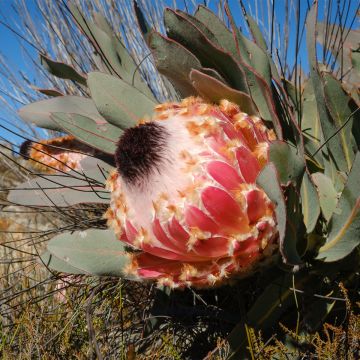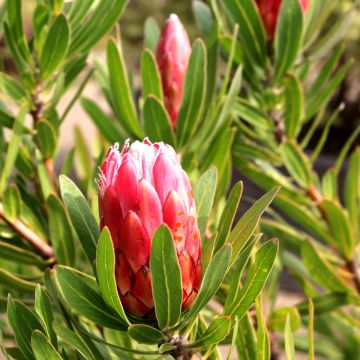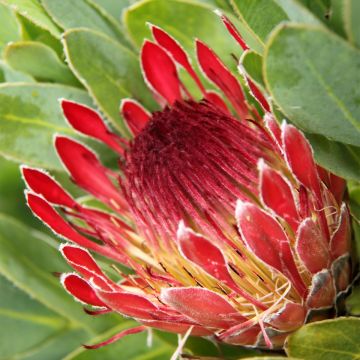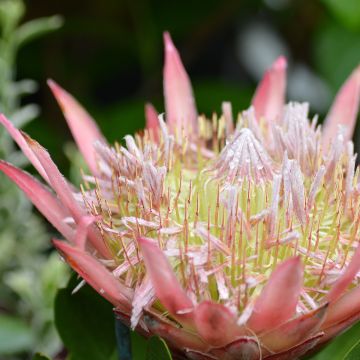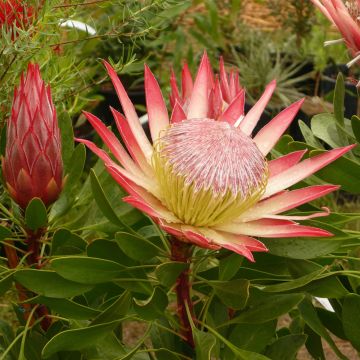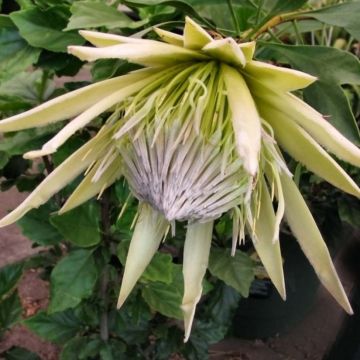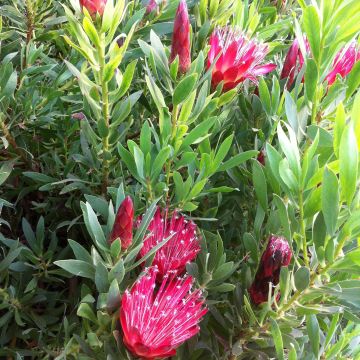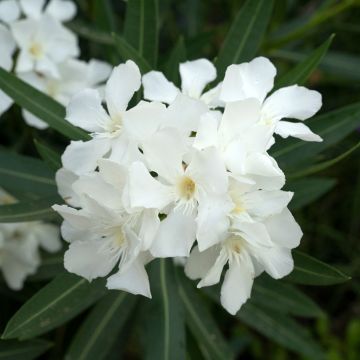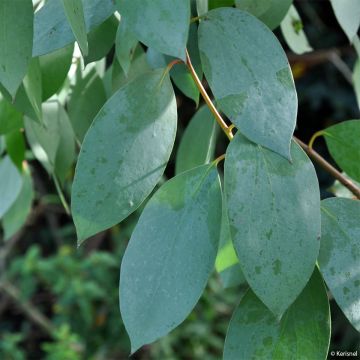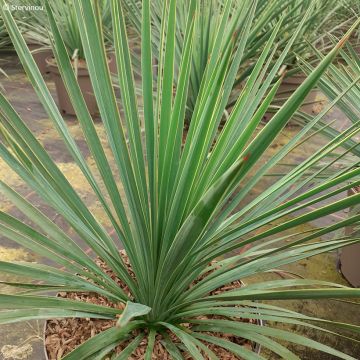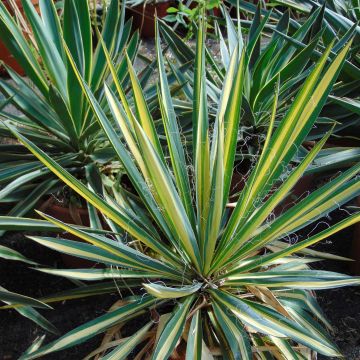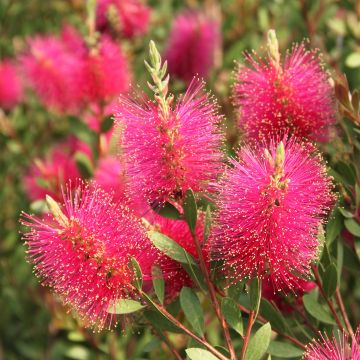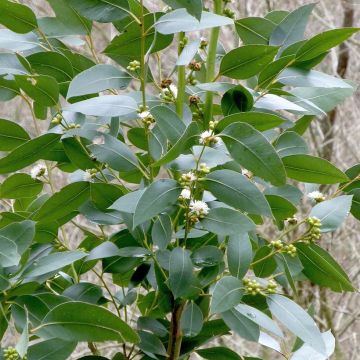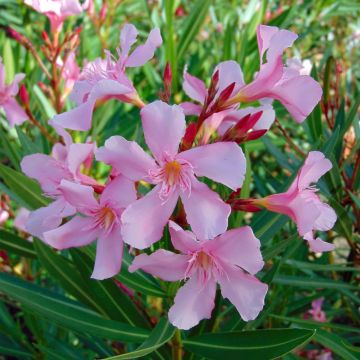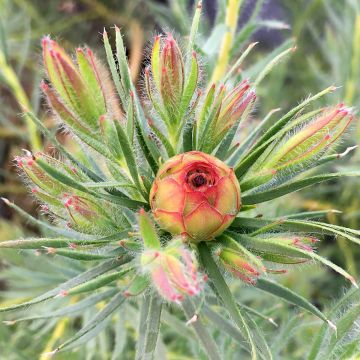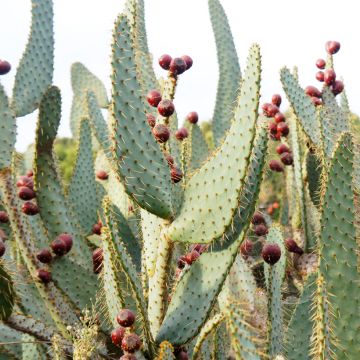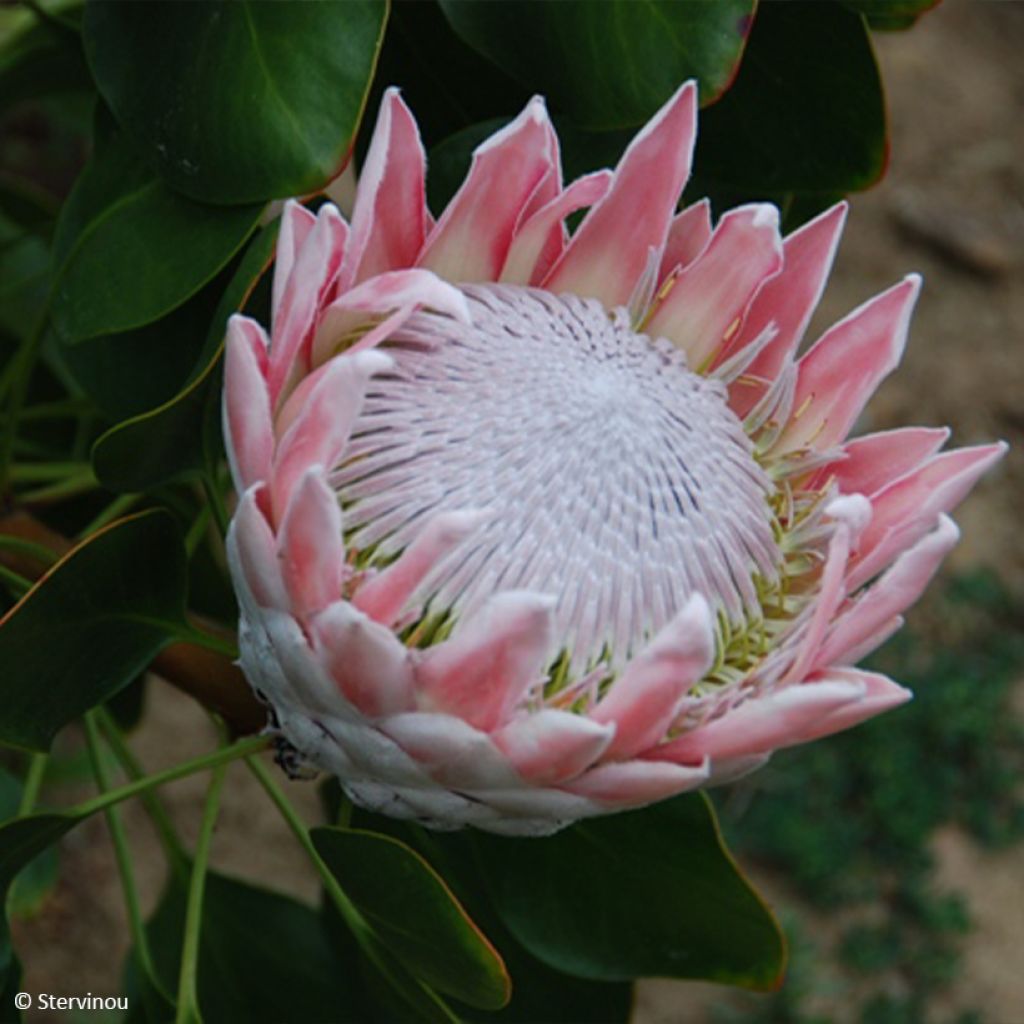

Protea cynaroides (Seeds)
Protea cynaroides (Seeds)
Protea cynaroides
King Protea, Giant Protea
Why not try an alternative variety in stock?
View all →This plant carries a 24 months recovery warranty
More information
We guarantee the quality of our plants for a full growing cycle, and will replace at our expense any plant that fails to recover under normal climatic and planting conditions.
From €5.90 for pickup delivery and €6.90 for home delivery
Express home delivery from €8.90.
Does this plant fit my garden?
Set up your Plantfit profile →
Description
The king protea, in Latin Protea cynaroides, is the floral emblem of South Africa. It is a delicate, but spectacular and fascinating perennial shrub. This botanical species produces floral heads in the shape of large flared cups, formed by pink and velvety bracts surrounding a heart of powdery pink flowers with white. Flowering takes place from April to October, depending on the climate, and the flowers are very long-lasting in dried bouquets. Cultivation in large pots is essential except in very mild areas.
The king protea is a perennial shrub of the protea family. Widely distributed in South Africa, it varies in colour and shape, adapting to many mountain environments without frost. The plant, with sucker roots, develops multiple thick stems, branching from the base. It will reach between 40 cm and 1.20 m in height, and will slowly spread over time. The stems bear, at the end of long red petioles, alternate, elongated and pointed, leathery leaves, which can absorb atmospheric moisture. Flowering takes place from April to October. The inflorescences are large heads, carried at the terminal part of each branch. They measure 12 to 30 cm in diameter. Mature and well-established plants are capable of producing up to ten heads per season. The flower buds resemble magnificent artichokes with pearly scales. The head opens and the bright pink and velvety bracts unfold to a velvety, white to pink, powdery plateau. This flowering attracts many pollinating insects and gives way to some velvety seeds almost as large as walnuts. The thick roots of this protea also serve as a storage organ. In case of fire, it is capable of regenerating from its roots, nourished by its own ashes.
Protea cynaroides is a mythical plant that leaves no one indifferent. It will prefer to settle in coastal gardens spared by heavy frost, in light, slightly acidic soil. It is particularly suited to the Mediterranean climate and thrives in poor, dry to arid soils. It can be planted as a solitary specimen, on large slopes or in the background of flower beds, in a dry garden, but always in an open position, in full sun. In an exotic garden, it can be associated with the Pride of Madeira, Leucadendrons, and Melianthus major, for example.
Report an error about the product description
Plant habit
Flowering
Foliage
Botanical data
Protea
cynaroides
Proteaceae
King Protea, Giant Protea
Leucadendron cynaroides
South Africa
Other Protea
Planting and care
A Protea is best planted in full sun, it needs a warm and bright location. Ideally, it should receive at least 6 hours of direct sunlight per day. The soil should be poor in organic matter. Avoid rich and humus-bearing substrates, as well as heavy and clayey soils. Ideally, the pH should be between 5.5 and 6.5. We recommend adding a little ash or charcoal to the planting soil.
Planting period
Intended location
Care
This item has not been reviewed yet - be the first to leave a review about it.
Mediterranean shrubs
Haven't found what you were looking for?
Hardiness is the lowest winter temperature a plant can endure without suffering serious damage or even dying. However, hardiness is affected by location (a sheltered area, such as a patio), protection (winter cover) and soil type (hardiness is improved by well-drained soil).

Photo Sharing Terms & Conditions
In order to encourage gardeners to interact and share their experiences, Promesse de fleurs offers various media enabling content to be uploaded onto its Site - in particular via the ‘Photo sharing’ module.
The User agrees to refrain from:
- Posting any content that is illegal, prejudicial, insulting, racist, inciteful to hatred, revisionist, contrary to public decency, that infringes on privacy or on the privacy rights of third parties, in particular the publicity rights of persons and goods, intellectual property rights, or the right to privacy.
- Submitting content on behalf of a third party;
- Impersonate the identity of a third party and/or publish any personal information about a third party;
In general, the User undertakes to refrain from any unethical behaviour.
All Content (in particular text, comments, files, images, photos, videos, creative works, etc.), which may be subject to property or intellectual property rights, image or other private rights, shall remain the property of the User, subject to the limited rights granted by the terms of the licence granted by Promesse de fleurs as stated below. Users are at liberty to publish or not to publish such Content on the Site, notably via the ‘Photo Sharing’ facility, and accept that this Content shall be made public and freely accessible, notably on the Internet.
Users further acknowledge, undertake to have ,and guarantee that they hold all necessary rights and permissions to publish such material on the Site, in particular with regard to the legislation in force pertaining to any privacy, property, intellectual property, image, or contractual rights, or rights of any other nature. By publishing such Content on the Site, Users acknowledge accepting full liability as publishers of the Content within the meaning of the law, and grant Promesse de fleurs, free of charge, an inclusive, worldwide licence for the said Content for the entire duration of its publication, including all reproduction, representation, up/downloading, displaying, performing, transmission, and storage rights.
Users also grant permission for their name to be linked to the Content and accept that this link may not always be made available.
By engaging in posting material, Users consent to their Content becoming automatically accessible on the Internet, in particular on other sites and/or blogs and/or web pages of the Promesse de fleurs site, including in particular social pages and the Promesse de fleurs catalogue.
Users may secure the removal of entrusted content free of charge by issuing a simple request via our contact form.
The flowering period indicated on our website applies to countries and regions located in USDA zone 8 (France, the United Kingdom, Ireland, the Netherlands, etc.)
It will vary according to where you live:
- In zones 9 to 10 (Italy, Spain, Greece, etc.), flowering will occur about 2 to 4 weeks earlier.
- In zones 6 to 7 (Germany, Poland, Slovenia, and lower mountainous regions), flowering will be delayed by 2 to 3 weeks.
- In zone 5 (Central Europe, Scandinavia), blooming will be delayed by 3 to 5 weeks.
In temperate climates, pruning of spring-flowering shrubs (forsythia, spireas, etc.) should be done just after flowering.
Pruning of summer-flowering shrubs (Indian Lilac, Perovskia, etc.) can be done in winter or spring.
In cold regions as well as with frost-sensitive plants, avoid pruning too early when severe frosts may still occur.
The planting period indicated on our website applies to countries and regions located in USDA zone 8 (France, United Kingdom, Ireland, Netherlands).
It will vary according to where you live:
- In Mediterranean zones (Marseille, Madrid, Milan, etc.), autumn and winter are the best planting periods.
- In continental zones (Strasbourg, Munich, Vienna, etc.), delay planting by 2 to 3 weeks in spring and bring it forward by 2 to 4 weeks in autumn.
- In mountainous regions (the Alps, Pyrenees, Carpathians, etc.), it is best to plant in late spring (May-June) or late summer (August-September).
The harvesting period indicated on our website applies to countries and regions in USDA zone 8 (France, England, Ireland, the Netherlands).
In colder areas (Scandinavia, Poland, Austria...) fruit and vegetable harvests are likely to be delayed by 3-4 weeks.
In warmer areas (Italy, Spain, Greece, etc.), harvesting will probably take place earlier, depending on weather conditions.
The sowing periods indicated on our website apply to countries and regions within USDA Zone 8 (France, UK, Ireland, Netherlands).
In colder areas (Scandinavia, Poland, Austria...), delay any outdoor sowing by 3-4 weeks, or sow under glass.
In warmer climes (Italy, Spain, Greece, etc.), bring outdoor sowing forward by a few weeks.

































